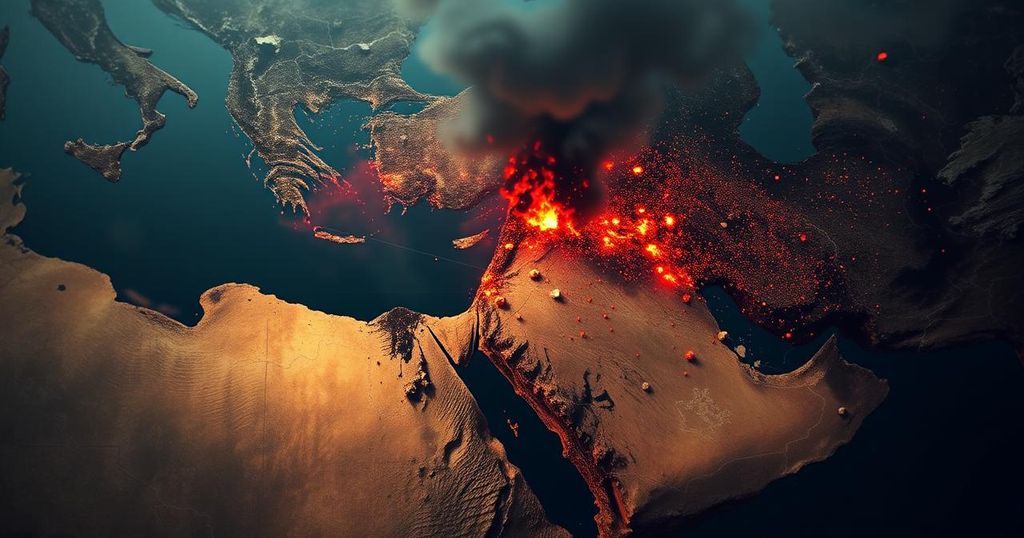Escalating Regional Tensions: Iran-Linked Militias in Iraq Increase Attacks on Israel
Iran-backed militias in Iraq have ramped up attacks on Israel, launching approximately 40 strikes in two and a half weeks. The increase follows heightened conflict involving Hezbollah and the Gaza war. Analysts suggest that Iranian proxies are mobilizing in support of Hezbollah amid Israeli military pressure. Israeli forces have not targeted Iraq directly but have intensified operations in Syria against Iranian interests. The situation highlights the complexities of Middle Eastern proxy dynamics and ongoing regional hostilities.
In recent weeks, Iran-aligned militias in Iraq have significantly intensified their missile, drone, and rocket attacks against Israel, reportedly launching around 40 such assaults in a span of just over two weeks. The assaults began in October 2022, coinciding with the outbreak of conflict in Gaza. However, according to research compiled by the Washington Institute, the frequency of these attacks surged dramatically following the Israeli airstrike that resulted in the death of Hezbollah leader Hassan Nasrallah on September 27, 2023. Founded in Lebanon with Iranian support over 40 years ago, Hezbollah remains a crucial part of the coalition of militant groups that Iran nurtures across the Middle East. As the capabilities of Hamas have diminished due to ongoing conflict in Gaza, and with Hezbollah under sustained Israeli military pressure, Iran has turned its attention to lesser factions within this coalition to counter Israel. Michael Knights, a prominent analyst at the Washington Institute, remarked, “The number of missiles and drones being fired from Iraq [at Israel] has gone through the roof. They’ve moved into a higher gear to demonstrate their support for Hezbollah.” This increase in missile firings highlights Iran’s broader strategic aim of leveraging its proxy militias within its “axis of resistance” to offer mutual support against Israel while simultaneously fostering competition among these factions. Despite the growing aggressiveness of Iraqi militias, their capabilities are viewed as inferior to those of Hezbollah, as Knights notes that they are “not as capable as Hezbollah and not as mad as the Houthis, so are kind of worried about being outshone by the other guys in the axis.” Iran’s proxies across Syria, Iraq, and Yemen, including the Houthi militia which has launched missiles at Israel, present potential targets for Israeli retaliation following Iran’s firing of 180 ballistic missiles towards Israel on October 1, 2023. The Israeli military has executed numerous airstrikes in Syria against Iran-linked sites over the past year, aimed at disrupting supply routes crucial for assisting Hezbollah. Incidents such as the recent explosion of pagers provided to Hezbollah members have illuminated the intricate relationships between these Iranian-backed groups across the region. Kirsten Fontenrose from the Atlantic Council described these explosions as a “momentary flash of light on a dark network map,” suggesting a growing intelligence opportunity to map Hezbollah’s operations globally. Meanwhile, Israeli forces have intensified their strikes on Iranian targets, particularly after the recent attacks by Hamas on October 7, 2023. A range of operations have targeted sites in Syria associated with Iranian weapons production and military infrastructure. These attacks have resulted in significant casualties, demonstrating Israel’s commitment to countering Iranian aggression. While Israel has yet to carry out strikes directly in Iraq, it has responded to Iranian influence and proxies in Syria, resulting in numerous casualties among militia forces linked to Iran and the Islamic Resistance of Iraq (IRI). The IRI has claimed responsibility for numerous attacks on Israeli and US forces since the onset of the conflict in Gaza. Furthermore, closer collaboration has been observed between the IRI and the Houthis, who have extended their network into Iraq. Recent US military operations in Baghdad reflect the intertwining of these proxies and their collective threat presented to US forces in the region. Notably, Israel has executed direct attacks in Yemen, targeting Iranian interests, thus indicating a strategic expansion of its operations beyond Syria and Iraq. The significance of the tumultuous situation in Iraq and Syria has largely gone overlooked in mainstream media and policy discussions. As Knights pointedly states, “Every big war has its forgotten corners.”
The ongoing conflict involving Iran-backed militias in Iraq represents a broader geopolitical struggle occurring in the Middle East, particularly between Iran and Israel. Following the escalation of violence in Gaza, there has been notable activity involving various factions supported by Tehran, including Hezbollah in Lebanon and the Houthis in Yemen. The situation is further complicated by a vigorous Israeli military response aimed at neutralizing Iranian influence in the region, especially through strategic airstrikes against key assets and sites associated with Iranian military operations. Understanding the interactions among these groups is crucial for grasping the intricacies of Middle Eastern politics and the persistent conflicts that define the landscape.
In summary, the recent escalation of attacks by Iranian-aligned militias in Iraq against Israel underscores a significant shift in regional dynamics following heightened tensions after Israel’s airstrike on Hezbollah leadership. The interplay between these various proxy forces signifies Iran’s intent to project power and support allied groups while countering Israeli military operations. As this conflict progresses, continued vigilance and military responses from both Israel and the United States are expected, further intertwining the fates of these multiple factions across Iraq, Syria, and the broader region.
Original Source: www.theguardian.com




Post Comment